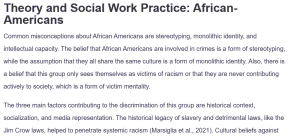Theory and Social Work Practice: African-Americans
Common misconceptions about African Americans are stereotyping, monolithic identity, and intellectual capacity. The belief that African Americans are involved in crimes is a form of stereotyping, while the assumption that they all share the same culture is a form of monolithic identity. Also, there is a belief that this group only sees themselves as victims of racism or that they are never contributing actively to society, which is a form of victim mentality.
The three main factors contributing to the discrimination of this group are historical context, socialization, and media representation. The historical legacy of slavery and detrimental laws, like the Jim Crow laws, helped to penetrate systemic racism (Marsiglia et al., 2021). Cultural beliefs against African Americans passed through generations increase discriminatory behavior toward the group (Simmons University, 2008). Most importantly, the negative portrayals in the media about African Americans also increase harmful biases and stereotypes in society.
Moreover, factors that can cause individuals to join supremacist groups are, firstly, the fear of others, where a person lacks exposure to various cultures, leading to fear that pushes people to seek comfort in others with the same mindset (Marsiglia et al., 2021). Others may join such groups to find a sense of identity and community, which often happens when they feel alienated. Finally, these groups are formed to exploit social and economic grievances (Marsiglia et al., 2021). What stands out is how they frame their narratives to blame marginalized communities for other broader social issues.
A social worker can, therefore, use historical and present-day facts to achieve positive social change. First, social workers can educate clients on the history of racism and its impact on society. They can also inform people of inequalities and their effects (Marsiglia et al., 2021). Further, a social worker can use personal stories from African Americans to challenge stereotypes and promote harmony within a community. Another approach is policy advocacy, where social workers can advocate for policies protecting the marginalized and encouraging practices inspiring equality.
Furthermore, a social worker can use various theories to challenge beliefs and enhance growth. Firstly, the critical race theory (CRT) can be applied to help clients understand how laws and systems increase inequalities (Marsiglia et al., 2021). The social worker can then encourage individuals to advocate for change. Second, the empowerment theory can enable clients to recognize and use their strengths against oppression (Simmons University, 2008). A social worker can use cognitive behavioral therapy (CBT) to help the oppressed develop healthier views.
The following recommendations are suggested as ways of confronting challenging worldviews. The first is dialogue and education, where open discussions about race, identity, and privilege can strengthen understanding of existing prejudice and foster understanding (Marsiglia et al., 2021). Another recommendation is to encourage diverse community engagement to reduce fear and misconceptions. In addition, a social worker can advocate for policies and practices that promote inclusivity and representation to destroy systemic barriers.
References
Marsiglia, F. F., Kulis, S. S., & Lechuga-Peña, S. (2021). Diversity, oppression, and change: Culturally grounded social work. (3rd ed.). Oxford University Press.
Simmons University. (2008, December 18). Gary Bailey “The color of fear: The paradox of race and oppression in the new millennium” [Video]. YouTube. https://www.youtube.com/watch?v=7U9lOtxwDTk
ORDER A PLAGIARISM-FREE PAPER HERE
We’ll write everything from scratch
Question 
Readings:

Theory and Social Work Practice: African-Americans
Over the past several weeks, we have explored various historical events and their impact on differing cultural groups. This week, students will examine and apply theories to understand individual or group behaviors, and actions to implement positive social change. To stimulate critical thinking, students will explore and answer the following:
- Select a cultural or oppressed group to apply your answers (i.e. Jews, African-Americans, Latinx, LGBTQ+, Military, Disabled, TANF, Migrants).
- *Please Note: selected group is African American.
- *Identify common misconceptions about the group selected.
- *What factors contribute to discrimination, racism, or racist beliefs?
- *What factors or fears cause individuals to join supremist groups or shun people who are different?
- *How can social workers use historical and present-day facts to help clients understand the underpinnings of inequality to promote positive social change? Give examples.
- *How can social workers apply theory to help clients challenges these beliefs and enhance growth? What recommendations are suggested to confront challenging world views?